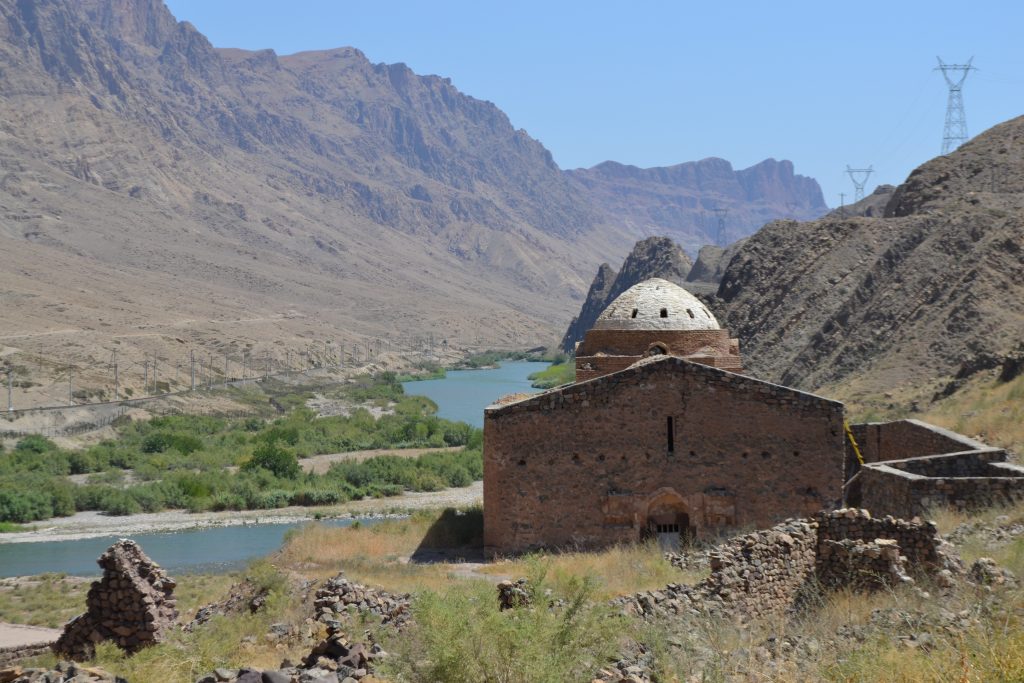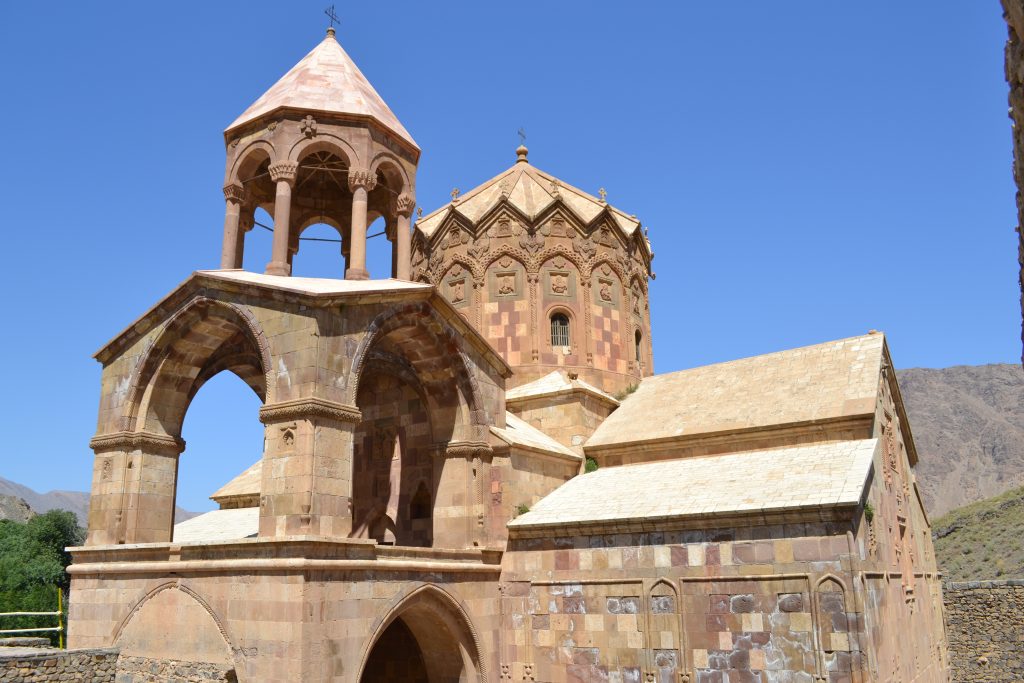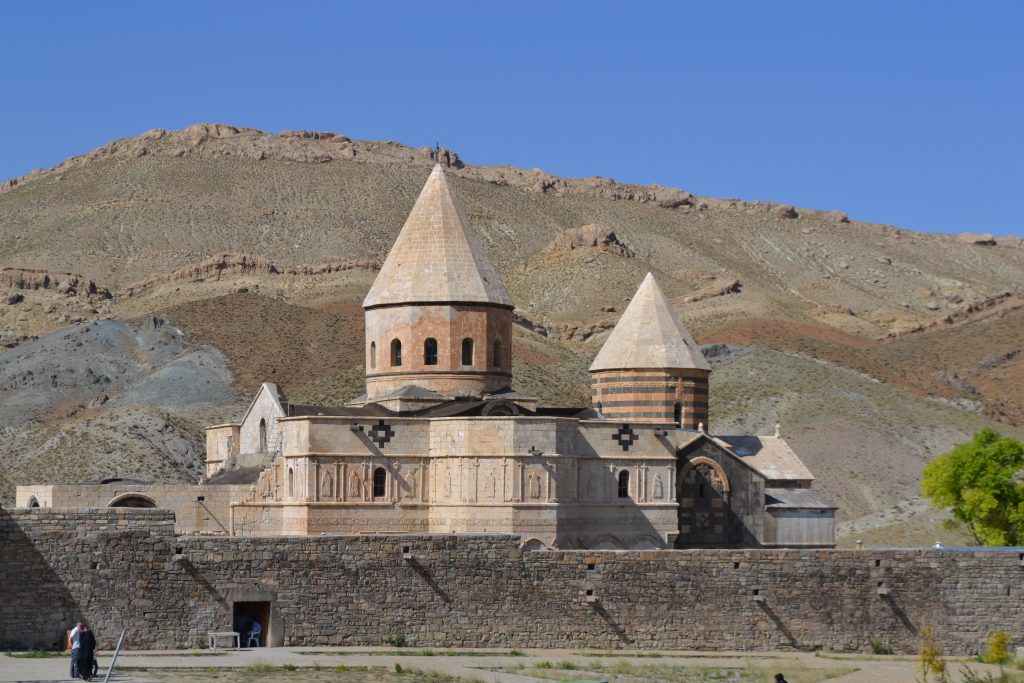Ajam Media Collective recently worked with THE STATE, a Dubai-based publishing practice, to make a ‘zine. We provided the words and art while they provided the design to make a wonderful collaborative document. Please also read our introduction. All photographs in this essay are by the author.
Dotting the deep valleys of the Aras River separating Iran, Azerbaijan, and Armenia, are a number of timeworn structures serving as testaments to the removal of old communities from the mountainous landscape. On the southern bank of the Aras, the Armenian Monastic Ensembles of Iran are the vestigial traces of the hundreds of years of Armenian life in the region. Yet, no Armenians remain in the countryside (though they form large communities in other parts of Iran). Designated as UNESCO World Heritage sites in 2008, these monuments act as a celebration of the past, but not an examination of it. One may ask: where are the Armenians who lived here, if only their buildings remain? As landmarks are indoctrinated into the cult of heritage, we are able to consecrate something that speaks to cosmopolitanism without actually having to live it, or ask the question why the past no longer resembles the present.

Numerous Armenian settlements had existed in the lowlands of the Southern Caucasus since the 7th century CE in what is now known as Iranian Azerbaijan and Azerbaijan’s Nakhchivan Autonomous Republic. The area became a thriving center for the Christian faith, and ornate churches and monasteries, such as the St. Thaddeus Monastery and the Church of St. Stephanos, were erected. At the crossroads of two continents, the inhabitants of the region gained enormous wealth through mercantile activities, extending trade networks out towards the Iranian Plateau, the Levant, and the Western Mediterranean. In 1604, however, the war between two rival empires—the Ottoman and the Safavids—reached a bloody apex, and Shah Abbas I implemented a scorched-earth policy that forcefully deported many Armenian communities from their homeland. Some communities situated on the banks of the Aras (like the famous town of Julfa), were granted land by Shah Abbas I on the outskirts of Isfahan and rose to new economic heights. But the human geography of the region was forever altered, devoid of a population that once called the area home, but their material culture remained.

The 20th century brought about another wave of ethnic cleansing to the northern bank of the Aras River Valley and its surrounding regions, this time due to the rising waves of nationalism. Two major events bookend the period that resulted in the further displacement of Armenian communities: the 1915 Armenian Genocide carried out by nationalist forces in the late Ottoman Empire, and the 1988-1994 Nagorno-Karabakh War between the Republics of Armenia and Azerbaijan (when around 250,000 Azeris were made refugees as well). While these two conflicts focused on the erasure of bodies from the landscape, they also resulted in the destruction and appropriation of physical structures like churches, monasteries, and graveyards in an attempt to erase the evidence of the inhabitants that threaten the homogenizing narratives of nationalism. Identity can often reside in the material; a structure can cement social and communal belonging, the destruction of the physical is an erasure of the memory of lived experiences.
The Iranian side of the Aras River was not engulfed by the post-Soviet irrendentisms on the northern bank, and thus the churches remained. With their inscription in 2008, these buildings have not only become protected sites of Armenian memory, but have been subsumed under the discourse of “world heritage.” However, as French historian Pierre Nora warns, the establishment of a monument removes the public’s obligation to remember the past. The celebration and restoration of the Armenian churches in Iranian Azerbaijan does not evoke the history of ethnic cleansing in the larger region; instead it masks such conflict and glorifies a past multiculturalism without discussing where the builders of said monuments went.
That said, the monasteries of the Aras River valley and the surrounding areas have played a significant role in Armenian collective memory. Considered some of the oldest churches in Christendom, they serve as sites of pilgrimage for many of Armenians from cities like Tabriz, Urmia, Tehran, Isfahan, and Qazvin. Every July, hundreds of Armenian Christians gather at the St. Thaddeus Monastery near the town of Maku in West Azerbaijan to attend the church’s annual service. The pilgrimage is not only a testament to religious devotion, but also serves as a ritualistic witnessing to the past presence of their community.

Since the reinscription of these monasteries to ‘world heritage sites,’ some national authorities and media outlets have used this pilgrimage as a promotional tool to appeal to a globalized neoliberal understanding of multiculturalism.
Despite this marketing strategy, the Iranian state has consistently denied certain ethnic groups (like the Kurds living only a few kilometers away from these landmarks) the right to gather and learn their mother tongues, even though this language education is protected in Article 15 of the Iranian Constitution. The materialization of heritage acts as a signifier of diversity without actually having to engage with the recognition of minority rights.
Although heritage can subsume past violence and present political struggles faced by communities under a veneer of multiculturalism, the integration of the monasteries into the industry of international cultural tourism has imbued these structures with new meanings and functions for the non-Armenian communities that interact with them. With the allocation of state and international funds for the repair and renovation of these sites, many urban Iranians (Azeri and Persian-speakers alike) flock to these newly restored buildings for weekend trips and getaways. Additionally, the influx of capital has economically rejuvenated the region and has provided new opportunities and sites of employment for the local rural Kurdish and Azeri populations.

The Armenian Monastic Ensembles of Iran are examples where the discourses of heritage, memory, and cosmopolitanism are embedded into the material world. World heritage sites can be branded as celebrations of multiculturalism while simultaneously removing the duty of the public and the state to address contemporary homogenizing political processes or to remember historical conflicts that cleansed the region. However, the recent interest in these landmarks have created new socio-cultural and economic circumstances that allow Armenians, Persians, and Azeris to interact with the churches in a new way.












3 comments
Fascinating article series. Thank you